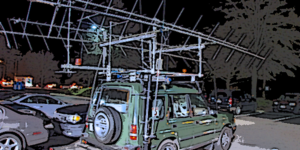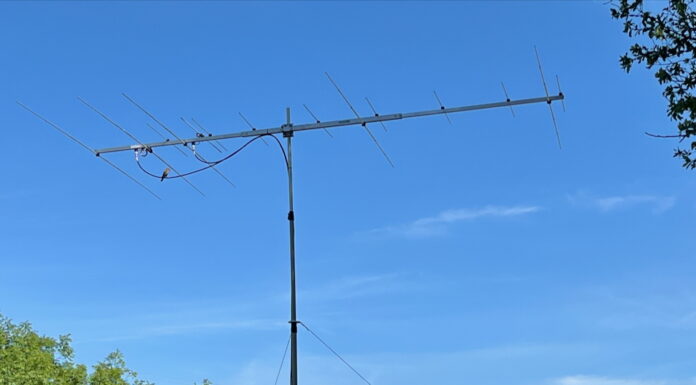The highlight for me was working a number of rovers (KC5WX, K5GJ, and K2EZ) and working quite a few meteor scatter contacts using FSK441. A few of those were so close that they were more likely direct RF blasts. But they put new grids in my log, particularly on 2 meters.
Rover Extraordinaire
 The photo with this post is not my own. It’s just one I found and dressed up a bit in Photoshop. I feel it captures the essence of these amazing people who setup some incredible rolling stations and then get on the road to hand out QSOs.
The photo with this post is not my own. It’s just one I found and dressed up a bit in Photoshop. I feel it captures the essence of these amazing people who setup some incredible rolling stations and then get on the road to hand out QSOs.
I got to see Gene, KC5WX, and his rover at the Cowtown Hamfest in January. He has an IC-9100 with amplifier along with a push-up mast (guyed) with 6 and 2 meter yagis. He got out to EM24 and EM14, which were new grids for me on both 6 and 2.
I saw Greg, K5GJ, and his rover at the Central States VHF Society Conference in Austin, TX, in 2014. It covers 6 meters through 10 GHz! I was able to pick up a few contacts from him including EM11.
One rover that caught my interest was K2EZ. You can find her story on QRZ.com. Just enter her call sign. She started her roving in Pennsylvania. Then she drove through Ohio, Kentucky, Tennessee, Arkansas, and Texas making contacts all along the route – while driving! I picked her up as she hit Dallas and turned toward Houston. What an incredible rover route!
Meteor Scatter
The other highlight was working quite a few meteor scatter contacts, thirteen in total. A few of them were very close by, which was all my 2 meter setup could be expected to accomplish. But a select few, on 6 meters, were fairly long distance. This included AG0N in DN81, in my home state of Nebraska; W4NH in EM84; K0RI in DM78, K0TPP in EM48; W9RM in DM58; K0TPP in EM48, and W0JW in EN31. I also worked W5LDA in EM15 (2 meters), KC5WX/R in EM24 and EM14 (both 6 and 2 meters), KB7IJ in EM12, and K5DOG in EM00 (2m and 70cm).
I really enjoy MS when you see those bursts come through. For one of the contacts the burst was so strong and sudden that I thought some local operator had just fired up on the frequency. Others of course could barely be seen. Still a few more attempts at contacts didn’t work at all with nothing heard. I appreciate those ops that stuck with me to make the contact work and those who took on the challenge of working my pipsqueak station.
You can see my further thoughts on this topic at Meteor Scatter – A Burst of Excitement.
Band Breakdown
Here’s my contact breakout by band:
- 6 meters = 23 Qs and 12 grids
- 2 meters = 29 Qs and 11 grids
- 70 cm = 7 Qs and 4 grids
My total score came in at 1,782.
Equipment Preparation
Prior to the contest I spent some time with my IC-910H. While I had purchased a USB interface cable for logging and control for N1MM+ as well as satellite control with SATPC32, I replaced it with a full USB and audio interface. This allowed me to do the FSK441 contacts. You can find the details on both interfaces at XGGComms.com. I made the purchases on eBay.
The week prior to the contest Steve, K5DOG, was kind enough to work me on ISCAT to validate that things were working OK.
I also spent some time testing the IC-910H power output with a Bird 6154 Termaline wattmeter. I just purchased this wattmeter on eBay. I like that it covers 25 MHz to 1 GHz and has a built-in dummy load rated at those frequencies. It only goes to 150 watts, but for my station that is perfect.
What I found was that the IC-910H, also purchased on eBay, was only putting out 50 watts on 2 meters (rated at 100 watts) and 40 watts on 70 cm (rated at 75 watts). Discussing this with Matt Adrian, KD8ZB, at Icom’s Service Center in Michigan, he thought it needed replacement driver transistors. (I worked with Matt at Heathkit and heartily recommend his services).
I also learned that the IC-910H frequency was off about 250 Hz on 2 meters and 500 Hz on 70 cm. So, I’ve ordered the CR-293 High Stability Oscillator. As soon as it arrives, I’ll ship it and the rig to Matt for installation, repair, and calibration.
VHF Contesting Fun
Again, this was a fun contest even though there was no Sporadic E opening on 6 meters. I had great fun on 2 meters, which was the go-to band, and moving QSOs to 6m and 70cm.
Thanks to everyone who worked me and many more who tried.








